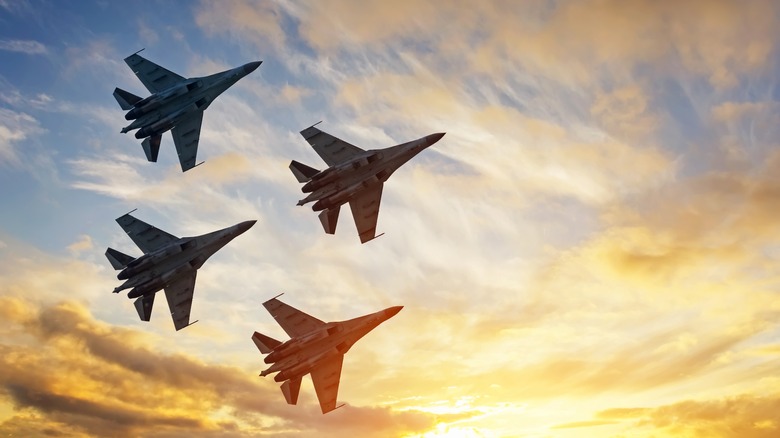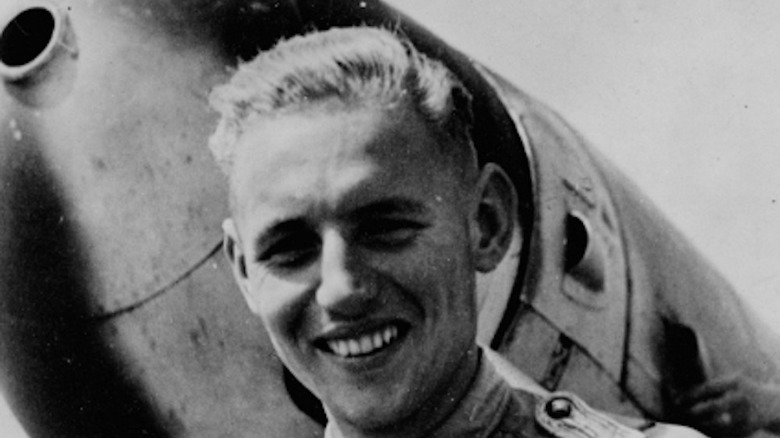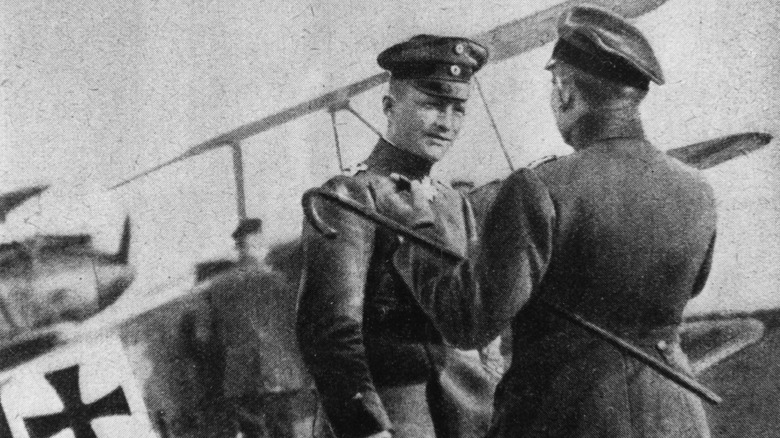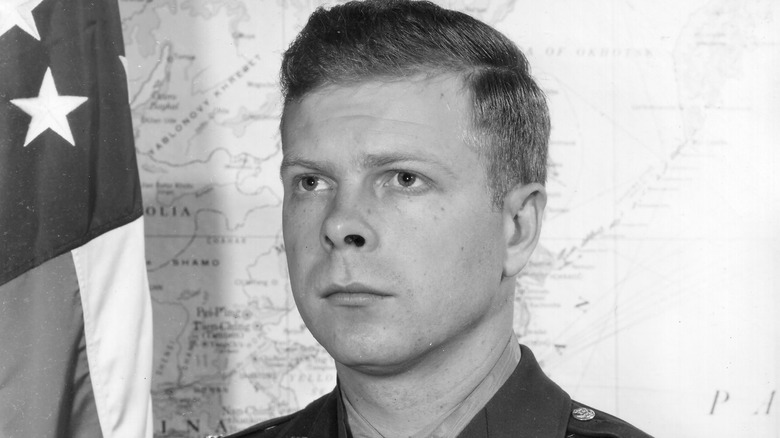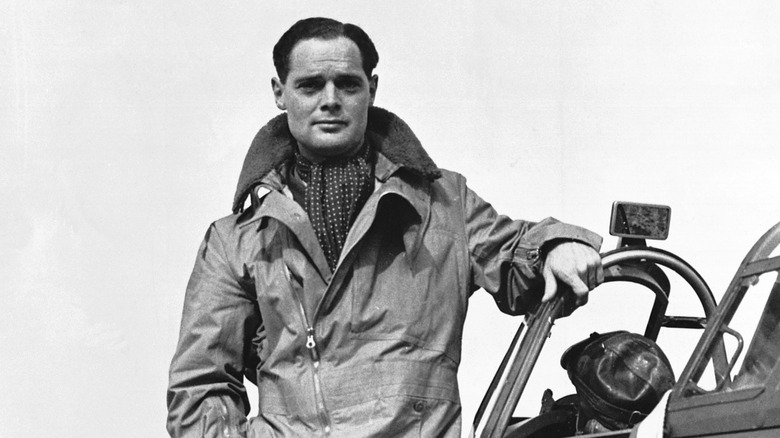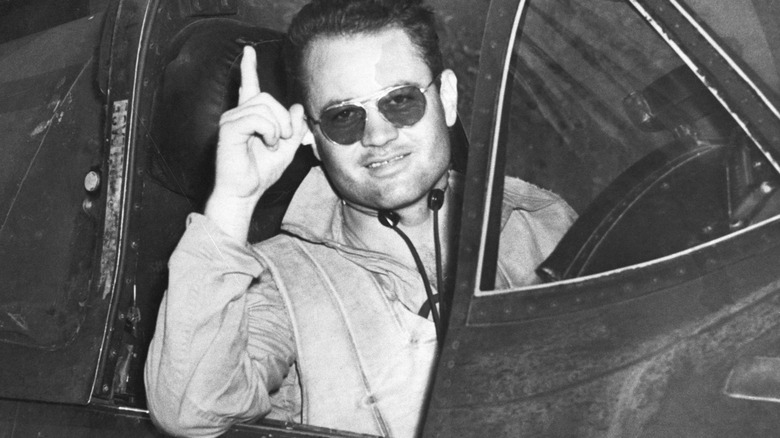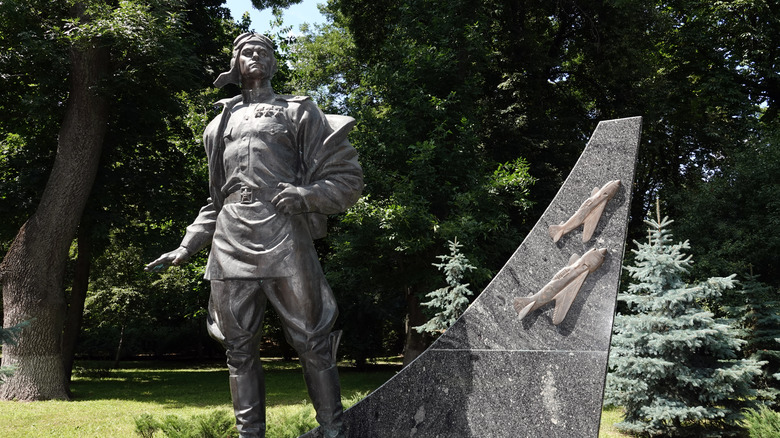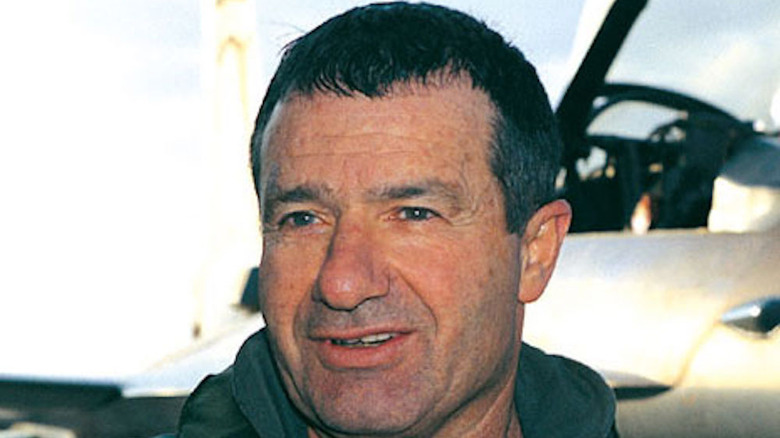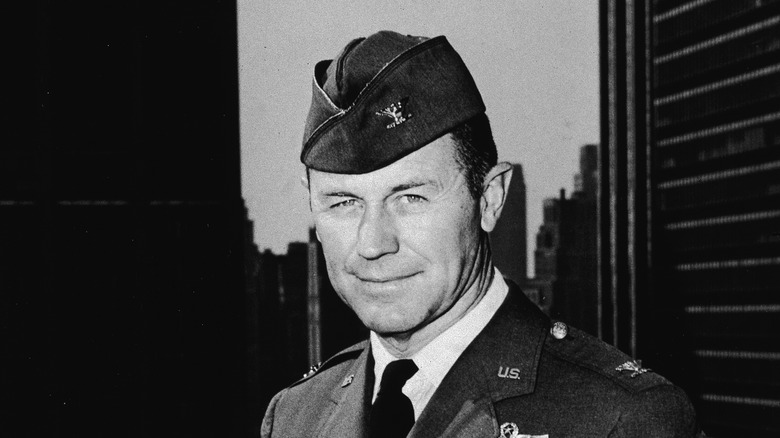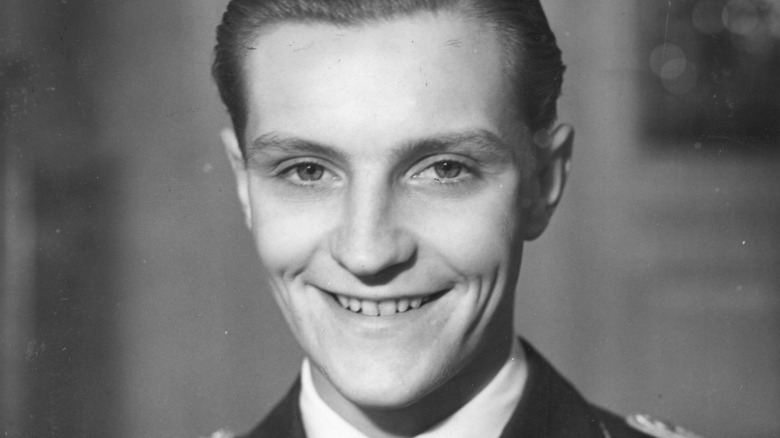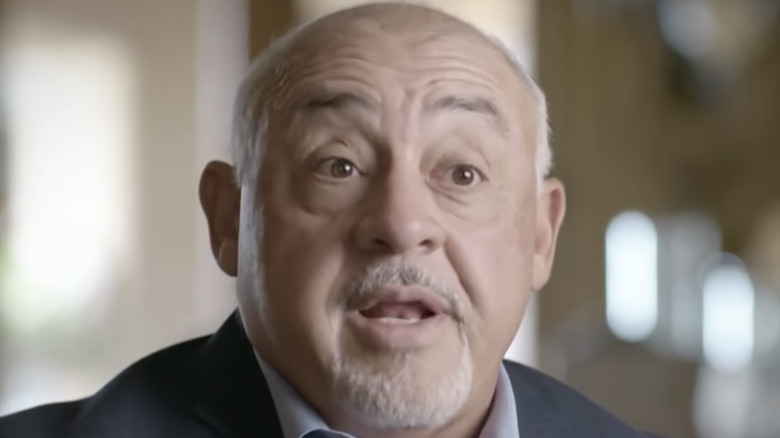10 Of The Most Legendary Fighter Pilots In History
Ever since mankind took to the skies and started shooting at other people while airborne, the iconic image of the flying ace has captured the popular imagination. Whether behind the yoke of a biplane or a hypersonic jet, combat aviators have carved out a reputation as fearless fliers whose exploits have shaped the course of the war over the past century and change, tallying victories with their skill, strategic brilliance, and the ice water that flows in their veins.
As air power became one of the defining elements of modern warfare, a select group of individuals harnessed the power of cutting-edge technology to dominate the skies and shape the course of combat, and perhaps even history itself. Through their fighting spirit and unmatched prowess, these aces of air combat set the standard for aviation and etched their names in the annals of legend.
Here's a look at 10 of the most decorated, most skilled, and most daring pilots to grace the cockpit.
Erich Hartmann
He might not have the name recognition for Western audiences of some of the other pilots on this list, but Erich Hartmann is widely considered the most successful flying ace of all time. He notched a mind-boggling 352 kills while operating with the Luftwaffe on World War II's eastern front, a number that will likely never be matched given the limited dogfighting involved in modern aviation and the Third Reich's unusual practice of keeping long-tenured pilots on frontline combat duty. What's more, he was never shot down by direct enemy action and never lost a wingman in flying a grand total of 1,400 missions.
Nicknamed "The Black Devil" by the Soviet aviators he faced in battle, Hartmann relied on strategic surprise and what biographer Erik Schmidt calls an "anti-dogfighting" approach (via Smithsonian Magazine), often striking before his targets were even aware he was there. His Messerschmidt Bf 109's distinctive paint job was so feared that the plane was often assigned to novices, who'd be able to fly it safely based on Hartmann's reputation, alone. Despite eventually serving 10 years in a Soviet prisoner of war camp, Hartmann survived the war and served out his career working with the West German and United States air forces, as well as taking work as a civilian flight instructor.
Manfred von Richthofen
The name at the top of this entry might not ring any bells, but that's only because its bearer was widely known by another moniker: "The Red Baron." Anyone who follows combat aviation history, has ever watched a "Peanuts" cartoon, or has eaten a frozen pizza since the 1970s is familiar with "The Red Baron" moniker, and that it's attached to the most feared of World War I flying aces. Air combat was still in a nascent phase during Europe's Great War, but Manfred von Richthofen was one of its premiere practitioners, notching 80 kills in his signature Fokker DR-1 triplane. For many pilots, attempting to camouflage their ride was a way of pursuing tactical advantage, but the Red Baron's bright, scarlet paint job told potential opponents they were about to face off with the German Empire's most feared aviator.
As the leader of a unit called "The Flying Circus," von Richthofen earned his notoriety over the skies of Europe during World War I. Despite his flamboyant reputation, nickname, and vehicular decoration, he was generally a conservative flier, preferring ruthless effectiveness over flash and derring-do. His reign in the skies came to an end in 1918 when, under combined fire from anti-aircraft ground installations and a plane piloted by Canadian ace Arthur Roy Brown, von Richthofen was fatally wounded and crash-landed. "The Red Baron" was only 25 years old at the time, but he'd done enough to solidify his place in aviation history.
Richard Bong
The most decorated and successful American combat pilot of all time, Richard Bong made his name flying missions in the Pacific Theater during World War II. He learned to fly in the Civilian Pilot Training program, and became a flying cadet in the U.S. Army Air Corps at the young age of 20, just in time for America's entry into the ongoing global conflict. Over the course of three years, he racked up an impressive 40 confirmed kills, most of them behind the stick of a P-38 Lightning, earning the nickname "Ace of Aces," and eventually, a Congressional Medal of Honor awarded by General Douglas MacArthur.
Like some other great pilots on this list, Bong wasn't a fan of intricate dogfighting, considering himself a substandard gunner. He preferred, instead, to close before engaging in a firefight with his opponent. Still, his skill as a pilot and impressive kill count are undeniable. Unfortunately, his love of aviation would lead to his untimely death. After returning home to a hero's welcome in January of 1945, Bong became a test pilot for Lockheed. On August 6 of the same year, he was killed while testing the P-80 Shooting Star. If that date sounds familiar, it's because it's also the day the first atomic weapon was dropped on Hiroshima. The fact that Bong's death was front-page news on such a momentous day demonstrates his significance in American combat aviation history.
Douglas Bader
There are pilots on this list with flashier, more numerically impressive careers than RAF pilot Douglas Bader. Perhaps some had better stick or gunnery skills, and others, like the Red Baron, certainly had a more fearsome reputation. However, Douglas Bader's story is significant, given that every single one of his 24 recorded and confirmed kills was notched after he lost both of his legs in a 1931 aerial acrobatics accident. At first invalided out of the Royal Air Force due to his condition, he reapplied for service once tensions began rising in Europe, and was reinstated in November of 1939.
Assigned to 242 Squadron, Bader was made squadron leader during the Battle of Britain. By the end of 1940, he had led his crew to a total of 67 enemy kills, one Distinguished Service Order, and nine Distinguished Flying Crosses. He was shot down and captured by the Germans in 1941, at which time his right prosthesis was damaged. A special order was given by Reichsmarschall Hermann Goering allowing for the delivery of a new leg from England, delivered via an unrestricted "bombing" run by a Bristol Blenheim. Bader's captivity ended when the camp where he was stationed was liberated by U.S. forces in April 1945, and his legend would grow with time. He passed away from what was believed to have been a heart attack in 1982, just two months after the release of "Reach For the Sky," a film based on his life.
Gregory Boyington
One of the striking things about the ace pilots of the 20th century's biggest wars is how young they tended to be when they were flying combat missions in some of the world's hottest theaters of war. Then, there's Gregory Boyington. Although he got his start at a young age, it wasn't until he hit his early 30s that he really made a name for himself as a flier — earning the nickname "Pappy" as a result. His most famous flying was done after he was appointed commanding officer of Marine Fighting Squadron 214. Nicknamed the "Black Sheep Squadron," Boyington's crew saw intense action in the Pacific Theater, often taking on harrowing missions in which they were outnumbered. It was there that Boyington would rack up most of his 28 kills before being shot down and taken prisoner in January 1944.
After spending some 20 months as a prisoner of war, Boyington was liberated when the war ended, and returned to the States to receive the Congressional Medal of Honor and the Navy Cross. His exploits would live on well after the war. First, he wrote an autobiography titled "Baa Baa Black Sheep," which was published in 1958. Then, his book was loosely adapted into a television series of the same name, in which Boyington was portrayed by actor Robert Conrad. The show aired for two years in the mid-'70s, and helped solidify Boyington's place in the pantheon of famous fighter pilots.
Ivan Kozhedub
World War II produced no shortage of airborne heroes, but on the Allied side, none could match the kill count of Ivan Kozhedub. The Ukraine-born flying ace recorded a confirmed 64 kills, although an anecdote says that it could have been more given Kozhedub's unwillingness to be credited for downing a plane he didn't see hit the ground with his own eyes. Getting his start as a flight instructor for the Red Army, Kozhedub put in a request for active duty once Germany invaded the Soviet Union in June 1941, but it wasn't until June 1943 that he was commissioned for combat. One year later, he would be awarded the second of his three gold stars as Hero of the Soviet Union, having completed 256 sorties and taken out 48 enemy planes.
While his kill number is obviously impressive, the shiniest bit of his legacy may be that he was the first Soviet pilot to shoot down a Messerschmidt-262, the Luftwaffe's pioneering combat jet, and is one of the few pilots to have done so at all. He was also never shot down himself, managing to land his plane after every round of combat, even after receiving damage. Details of his combat skills and techniques are still studied by Ukrainian pilots to this day.
Giora Epstein
You may have noticed that most of the names on this list flew prop planes. The supersonic jet era changed a great deal about air combat, with engagements often taking place at greater distances, and dogfighting becoming less of a dedicated practice. Still, steel nerves and skill behind the stick remained crucial to the execution of operations even as the planes got faster and the weapons increased in range. Israeli pilot Giora Epstein is perhaps the best example of this truism, and remains today "The Ace of Aces" in the jet era. In a career that spanned over 30 years, Epstein notched 17 kills, most of which came during the intense fighting that took place in 1967's Six-Day War and 1973's Yom Kippur War.
Originally denied flight status due to a heart condition, Epstein persevered and was tabbed to fly the French Mirage jet for the Israeli Air Force. In service, he earned the nickname "Hawkeye" for his incredible eyesight; he was allegedly able to spot an aircraft at some 24 miles. He'd finish his military career flying the F-16, although he expressed displeasure at the increasing dependence on computer systems as compared to the Mirage. After finally retiring from active duty at the age of 59, Epstein, like many IAF veterans, became a pilot for civilian airline El Al. His name, however, remains at the top of the list of jet-powered aces.
Chuck Yeager
If you grew up American with any interest in aviation in the second half of the 20th Century, you're most likely familiar with Chuck Yeager. The West Virginia-born pilot earned his greatest fame as a test pilot, including being the first flier to break the sound barrier, which he accomplished in the Bell X-1. His name was so synonymous with aviation that, when video game company Electronic Arts published its first flight simulator game in 1987, it was titled, "Chuck Yeager's Advanced Flight Trainer." All of this, however, shouldn't overshadow Yeager's accomplishments as a combat pilot. During World War II, he flew missions in the venerable P-51 Mustang, earning a reputation for flight skill and keen combat strategy. In October 1944, he was the first pilot in his group to make "ace in day," marking five enemy kills on a single mission. He's also one of the very few pilots of any nationality to shoot down the Messerschmidt-262.
After his combat career ended, Yeager enjoyed a long tail of fame and stature. His sound barrier-breaking effort became the stuff of legend, and he'd go on to command the Air Force Aerospace Research Pilot School to train pilots for the space program. He passed away in 2020 at the age of 97, but not before having flown faster than the speed of sound once again at the age of 89, on the 65th anniversary of his record-breaking feat, no less.
Hans-Joachim Marseille
Given the intensity of the air combat over Europe during World War II, it should be no surprise that the Luftwaffe spawned several historically notable pilots. Few, however, are more intriguing than Hans-Joachim Marseille. A troubled child with a reputation for laziness in his studies, he found purpose as a pilot, although he was known for his unorthodox tactics and frequent disregard for numerical advantage and strategic convention. His natural talent, however, was beyond question, and he would accumulate some 158 kills. His most successful efforts were undertaken during the Third Reich's North Africa campaign, earning him the nickname "The Star of Africa." He would be killed in action in 1942.
Even more interesting than his exploits, however, was his personality. Marseille was known to flaunt authority, and possessed of a debonair and cocksure attitude that one could cite as a template for the popular image of the fighter pilot that persists today. Even though he fought in Hitler's military, Marseille was also vocally anti-Nazi, and is reported to have expressed his dislike for Hitler on multiple occasions. That type of thing might have been a death sentence for many during the Third Reich, but Hans-Joachim Marseille's unquestionable aptitude as a pilot kept him airborne and made him a popular name in the German military and culture, at large.
Cesar Rodriguez
While it's fun watching fictional pilots engage in stick-twisting dogfights in pop culture products like "Top Gun: Maverick," the truth is that air-to-air engagements of that sort have been a rarity in the late 20th and early 21st centuries, especially for American pilots. Increasingly advanced jets and weaponry have made the kind of seat-of-your-pants combat skills that were displayed through the Vietnam War less of a thing, overall.
Still, there have been pilots out there getting the job done for decades in conflicts all over the world, and one of the most recently decorated was Cesar Rodriguez. On his retirement from the Air Force as a colonel in 2007, Rodriguez had on record three air-to-air kills, which were the most for any active duty pilot at the time. His total tied him with three other men for the being closest American to becoming a flying ace since the Vietnam War.
Two of Rodriguez's kills took place during the Gulf War, during which he piloted his F-15 against Iraqi MiG-29 and MiG-23 platforms. The third occurred during peacekeeping operations over Kosovo, during which Rodriguez downed a Yugoslav MiG-29 on the first night of the campaign.
